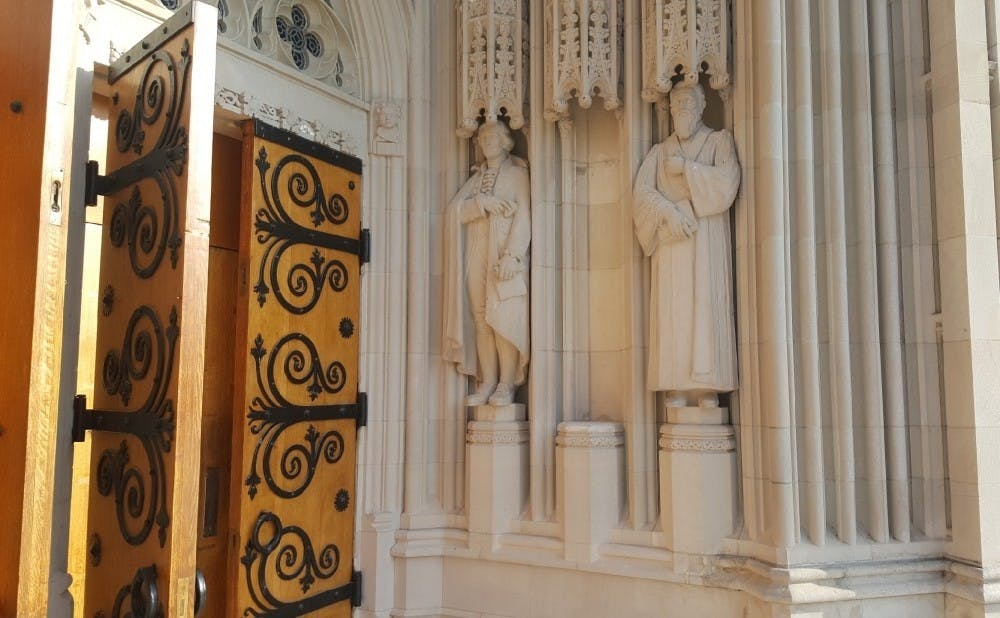In the wake of the University’s decision to remove a statue of Robert E. Lee from outside Duke Chapel, President Vincent Price created a commission to advise the administration on navigating Duke’s history. Now, the group has given Price its report, but the actual recommendations remain secret.
In August, Price issued three charges to the Commission on Memory and History, with the instruction to complete their work by Nov. 17. The commission was asked to propose principles to guide Price and the Board of Trustees when an issue arises about the appropriateness of a memorial or the naming of a facility on campus. In addition, members were asked to provide input as Duke develops procedures for applying these principles and to recommend options to replace the Lee statue. However, the actual recommendations are not yet available to the public.
“The commission delivered its report to the president by its deadline,” said Kristen Brown, associate vice president for news and communications. “We expect President Price to make a recommendation to the Board of Trustees, and that we will be able to make an announcement afterward.”
She noted that she is unsure what the communications process regarding the report will be after that.
Frank Emory—chair of the commission and partner at Hunton and Williams LLP—explained that it’s up to Price to decide what to do next now that the committee’s work is finished.
“I applaud the president in taking this step to get a group like this together,” he said. “In addition to being thoughtful, it shows the University recognizes how important these kind of historical questions are.”
The commission held two in-person meetings on campus with members from across the country flying in to attend. They also had a phone meeting and communicated via email to create the recommendations.
Emory added that the committee had a wide range of members, including an undergraduate and graduate student, and praised their dedication.
Jacqueline Robinson-Hamm, a Ph.D. candidate in biomedical engineering who served on the committee, said Price set a hard deadline to finish their work and that there was a sense of urgency in creating the policies.
The group spent time doing outreach to hear from different Duke communities and receive input from students and faculty members, she noted.
“Everyone on the commission was in agreement that if this is going to affect Duke and whole community, we need to make sure we reach out,” Robinson-Hamm said.
This included giving presentations to Academic Council, Graduate and Professional Student Council and Duke Student Government, as well as having an online comment box that anyone could fill out. Robinson-Hamm also sent out emails to student groups asking for their input and posted about it on Facebook.
The group studied schools like the University of Oregon and Harvard Law School that had undertaken similar efforts.
“It needs to be a policy that fits Duke, that fits our culture, but let’s not reinvent the wheel,” Robinson-Hamm said. “If other institutions have good policies, why not tweak them?”
William Ferris, professor of history at the University of North Carolina at Chapel Hill and a member of the commission, explained that the group considered how Duke is a constantly changing institution with a global reach but also has deep roots in the history of North Carolina and the South.
They also had to take into account how Duke’s population is rapidly changing, creating dynamics different than they were 10 or 20 years ago, he said.
A key goal of the commission was to examine the University’s principles and to create recommendations that reflect these.
“We talked about a shared sense of who we are and thinking about our values and how these are understood and expressed today,” Emory said.
Members also considered situations across the country in which other statues had been taken down and the circumstances that led to their removal.
Robinson-Hamm said that the group gave Price a list of recommendations for what to do about the space where the Lee statue once stood, including leaving it empty permanently or leaving it empty for a certain period of time. They also recommended certain individuals for statues to replace Lee, in case Price decides to follow that route.
Ferris noted that many colleges are dealing with similar issues around the legacy of racism on their campuses.
“Every campus has some version of this process that they’re dealing with now,” he said. “It’s to Duke’s credit that they’ve aggressively moved forward in taking down the statue of Robert E. Lee and commissioning a group to think in a thoughtful way about how to proceed in the future.”
Scholars at Princeton University have undertaken a “Princeton and Slavery” project, which aims to “investigate the University’s involvement with the institution of slavery.” In addition, Georgetown University has announced that it would award “preferential status” in the admissions process to descendants of slaves who worked for or were sold by the school.
Ferris explained that issues around racism and slavery have been around for more than 150 years but are more dramatically in our face today than ever before, which he attributes to how social media has made instances of racism more visible.
Colleges are uniquely suited to examine the legacy of racism and make positive changes, he said.
“The best way to deal with issues is to confront them, and universities are where such issues are addressed,” Ferris noted.
He explained that Duke being a private institution means it can enact change more rapidly than a public university might because it’s only accountable to its Board of Trustees, not a state legislature.
Emory said that the University's creation of the commission demonstrates its commitment to being thoughtful about decisions like removing a statue, instead of taking knee-jerk reactions.
“Duke’s approach shows that like in many things we do, we want to make sure we get the right answer in the right way,” he said.
Get The Chronicle straight to your inbox
Signup for our weekly newsletter. Cancel at any time.

